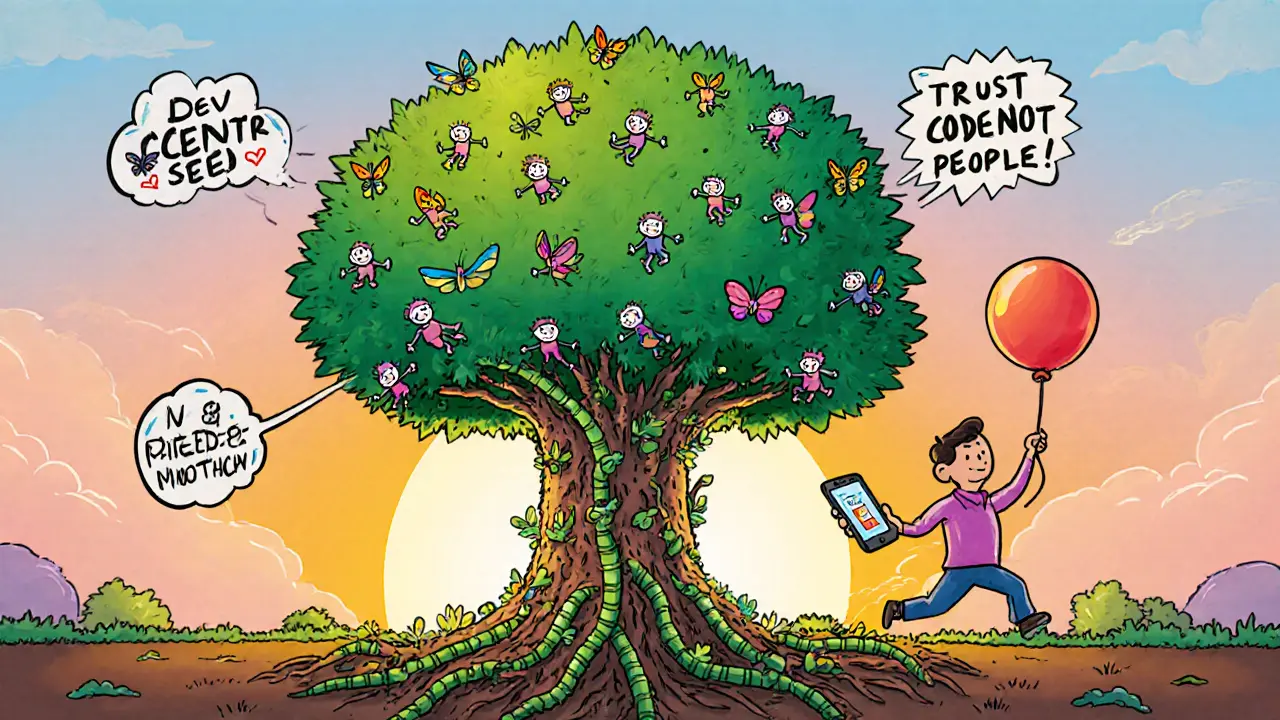Bitcoin Node Security Calculator
Bitcoin's security depends on having enough independent validators. This tool shows how network security changes based on the number of Bitcoin nodes.
Security Thresholds
Network Security Level
Strong security
Security improves with more nodes, especially when spread globally to avoid single points of failure
Why Node Count Matters
The article explains that Bitcoin's security comes from the number of independent validators, not just mining power. With 24,000+ nodes, the network is robust against attacks and censorship. If nodes drop below 10,000, the network becomes vulnerable to attacks. Below 5,000, Bitcoin would no longer be secure.
There are about 24,000 publicly reachable Bitcoin nodes right now. That number isn’t fixed-it changes daily, sometimes by hundreds. But what does it actually mean? Why should you care how many computers are running Bitcoin software around the world? The answer isn’t just technical. It’s existential for Bitcoin itself.
What Exactly Is a Bitcoin Node?
A Bitcoin node is just a computer running software that follows Bitcoin’s rules. It doesn’t mine. It doesn’t trade. It doesn’t hold your coins. But it does something far more important: it verifies every transaction and block on the network. Think of it like a librarian who checks every book returned to the library to make sure it’s not a forgery, then tells other librarians what’s real. There are different kinds of nodes. Full nodes store the entire Bitcoin blockchain-over 500 GB as of late 2025. They validate every rule: no double-spending, no fake signatures, no inflation beyond 21 million coins. Pruned nodes are a lighter version-they keep only the most recent part of the blockchain to save space. SPV nodes (lightweight wallets) don’t store the chain at all. They trust full nodes to tell them the truth. The real power comes from full nodes. They’re the ones enforcing Bitcoin’s rules without asking anyone’s permission. If a miner tries to create a block with fake transactions, full nodes reject it. No vote. No CEO. No central authority. Just code and consensus.How Many Nodes Are There Right Now?
As of October 1, 2025, two major tracking sites show nearly identical numbers: Bitnodes.io lists 24,266 reachable nodes, and Coin.dance shows 24,119. The difference is negligible. What matters is the trend: the number has been slowly climbing for years, even as the blockchain keeps growing. Of those nodes, about 19,049 are running Bitcoin Core-the original software created by Satoshi Nakamoto. The rest use alternative implementations like Knots or Bcoin. The most common version? Bitcoin Core 29.0.0, with over 2,500 nodes on it. That’s not random. It means most operators are keeping their software updated, which is critical for security. But here’s the twist: nearly two-thirds of all nodes-15,675 of them-don’t show a country. That’s not a glitch. It’s intentional. These are nodes running over Tor or VPNs. People are hiding their location on purpose. Why? Because they don’t want to be tracked, regulated, or shut down. That’s not a flaw in the system. It’s the point.Where Are Bitcoin Nodes Located?
The nodes that do show a country tell a clear story. The United States leads with 2,440 nodes-about 10% of the total. Germany comes second with 1,319. Then France (698), Canada (412), and Finland (398). Together, the top five countries account for less than 22% of identifiable nodes. This distribution looks uneven, but it’s actually healthy. Bitcoin was never meant to be evenly spread across every nation. It’s meant to be resilient. If one country cracks down-say, China in 2021-nodes just move. They pop up elsewhere. The fact that nodes exist in 102 countries means no single government can kill the network. The real danger isn’t the U.S. having the most nodes. It’s if too many people rely on centralized services like exchanges or cloud providers to interact with Bitcoin. If you’re not running your own node, you’re trusting someone else to tell you the truth. And that’s the opposite of what Bitcoin was built for.
Why More Nodes Mean More Security
Bitcoin’s security doesn’t come from mining power alone. It comes from the number of independent validators. Miners create blocks. But nodes decide which blocks are valid. If 90% of miners try to change the rules-say, to double the supply of Bitcoin-full nodes will ignore them. The chain will split. The miners’ blocks become worthless. The network keeps going with the honest nodes. That’s the core insight from Satoshi’s whitepaper: “The system is secure as long as honest nodes collectively control more CPU power than any cooperating group of attacker nodes.” It’s not about who has the most mining rigs. It’s about who has the most independent validators. Every new node adds another copy of the blockchain. Every new node makes it harder for an attacker to rewrite history. If you want to double-spend Bitcoin, you’d need to control more than half the nodes-not just the miners. That’s nearly impossible with 24,000+ independent operators spread across the globe. And here’s something people forget: nodes also help with network speed. When you send Bitcoin, your transaction needs to reach miners quickly. Nodes relay transactions. More nodes mean faster propagation. Fewer delays. Fewer failed transactions.What’s Holding People Back From Running a Node?
Running a full node isn’t hard-but it’s not easy either. You need:- At least 500 GB of free storage (and growing by about 1 GB every few days)
- A stable internet connection with decent upload speed
- Time to sync the blockchain-sometimes days, depending on your hardware

What’s Next for Bitcoin Nodes?
The blockchain will keep growing. By 2027, it could hit 1 terabyte. That’s a problem-if we do nothing. But the community is already solving it. Pruned nodes are one solution. New protocols like UTXO commitments and block compression are being tested. Some developers are exploring ways to store only the most important data on-chain and move the rest to off-chain archives. The goal isn’t to reduce security. It’s to make participation easier. Meanwhile, IPv6 adoption is rising. Tor nodes are growing. More people are running nodes from homes, not data centers. That’s the trend that matters: decentralization spreading deeper, not just wider.Why This All Matters
Bitcoin isn’t a currency because it’s digital. It’s a currency because it’s independent. It doesn’t need banks. It doesn’t need governments. It doesn’t need trust. It needs nodes. Every node is a vote for decentralization. Every node is a shield against censorship. Every node is proof that the network belongs to its users-not to corporations, not to regulators, not to central banks. If the number of nodes drops, Bitcoin becomes more vulnerable. If it drops below 10,000, the network becomes fragile. If it drops below 5,000, it’s no longer Bitcoin-it’s a controlled experiment. Right now, we’re at 24,000. That’s strong. But it’s not enough. We need more. Not just because it looks good on a chart. Because if we don’t, we lose the thing that makes Bitcoin valuable: its freedom.How many Bitcoin nodes are there as of 2025?
As of October 2025, there are approximately 24,200 publicly reachable Bitcoin nodes, according to tracking sites like Bitnodes.io and Coin.dance. This number fluctuates daily but has been steadily increasing despite growing storage demands.
What’s the difference between a full node and a lightweight node?
A full node downloads and verifies the entire Bitcoin blockchain-over 500 GB-and independently checks every transaction. A lightweight node (SPV) only downloads block headers and relies on full nodes to confirm transactions. Lightweight nodes are faster and use less space but don’t validate rules themselves.
Why do so many Bitcoin nodes show as "n/a" for country?
About 65% of Bitcoin nodes use Tor or VPNs, which hide their IP addresses and locations. This is intentional. Many operators prioritize privacy and resistance to censorship, aligning with Bitcoin’s original goal of avoiding centralized control.
Can Bitcoin survive if the U.S. shuts down nodes?
Yes. Even if the U.S. banned all nodes, the network would survive. Nodes exist in over 100 countries, and the majority of nodes are hidden behind privacy tools. Bitcoin’s design ensures no single country can control or shut it down.
Do I need to run a node to use Bitcoin safely?
No, but you’re trusting someone else if you don’t. Wallet apps and exchanges act as intermediaries-they tell you your balance. Running your own node gives you full control and verification. It’s the only way to truly own Bitcoin without relying on third parties.
How much storage do I need to run a Bitcoin node?
A full node needs at least 500 GB of storage as of 2025, and the blockchain grows by about 1 GB every few days. Pruned nodes reduce this to around 100 GB by keeping only recent data, making them practical for home users.
Are Bitcoin nodes getting harder to run?
Storage and bandwidth requirements are increasing, but so are solutions. Pruned nodes, better compression tools, and cheaper storage are making it easier than ever. The barrier is no longer technical-it’s awareness. Most people don’t realize they can run a node on a $50 Raspberry Pi.

Comments (16)
John Borwick
November 22, 2025 AT 18:51
Been running a full node on an old Raspberry Pi for two years now. No big deal. Just plug it in, let it sync, and forget about it. The real win is knowing my transactions aren’t being filtered by some exchange that might freeze them tomorrow. Bitcoin’s not about making money, it’s about not needing permission to move it.
Jennifer MacLeod
November 23, 2025 AT 09:35
Just checked my node status and it’s synced. Feels good to be part of the network. Not a tech wizard but I did it. You don’t need much to be part of something bigger.
Jane A
November 24, 2025 AT 10:48
24k nodes? That’s nothing. The real power is still in the mining pools and the big exchanges. You think a bunch of guys running nodes on their laptops is gonna stop the Fed? Wake up.
Jennifer Morton-Riggs
November 26, 2025 AT 08:15
It’s funny how we treat nodes like some sacred temple of decentralization when really, most of them are just hobbyists with too much time on their hands. The network doesn’t need 24k nodes. It needs one unstoppable force. And that’s not a node, it’s a movement.
Amanda Cheyne
November 27, 2025 AT 11:02
Did you know the government already knows where most of these nodes are? Tor doesn’t help. They track traffic patterns. The 15k hidden nodes? They’re all decoys. The real ones are in data centers owned by hedge funds. This whole thing is a performance.
Anne Jackson
November 27, 2025 AT 20:25
USA has the most nodes. Of course it does. We built this. The rest of the world just tags along. If you’re not running a node in the US, you’re just borrowing freedom you didn’t earn.
Matthew Prickett
November 29, 2025 AT 06:35
They’re lying about the node count. The real number is under 5k. The rest are fake IPs from bots. They want you to think Bitcoin is decentralized so you keep buying it. It’s a pump disguised as a revolution.
Caren Potgieter
November 30, 2025 AT 02:18
I run a pruned node on my old phone in Cape Town. It’s slow but it works. People say you need fancy gear but honestly? You just need to care. Bitcoin is for everyone, even if you’re on a 3G connection.
Linda English
December 1, 2025 AT 20:15
I appreciate how thoughtful this post is. It’s easy to get caught up in price charts and memecoins, but the real heartbeat of Bitcoin is in these quiet, persistent nodes-each one a small act of resistance, a quiet declaration of autonomy. I’ve been thinking about setting up a node myself, maybe this weekend, and I’m really glad there are people sharing this kind of insight without hype or fearmongering.
Julissa Patino
December 2, 2025 AT 11:26
nodes? more like noobs. 500gb? really? you gotta be kidding me. why not just use a wallet? its the same thing. and tor? lol. everyone knows its tracked. this whole thread is so last year.
Omkar Rane
December 4, 2025 AT 04:07
Back home in India, most people think Bitcoin is just a way to send money abroad. But I showed my uncle how to run a pruned node on his old tablet. He didn’t understand the tech, but he smiled when he saw his own node online. That’s the real power-not the number, but the shift in mindset. It’s not about owning Bitcoin, it’s about owning your own truth.
Daryl Chew
December 5, 2025 AT 14:50
They’re watching the nodes. Every sync, every connection. The NSA has been harvesting node IPs since 2018. The 24k number? It’s a trap. They want you to think you’re safe because you’re ‘anonymous’. You’re not. You’re just another data point.
Tyler Boyle
December 6, 2025 AT 11:25
Most people don’t realize that the node count is a lagging indicator. The real signal is in the number of new full node releases per week. Bitcoin Core 29.0.0 dominating? That’s the real story. It means the community is still coordinated, still updating, still resisting fragmentation. That’s more important than raw numbers.
Kathy Alexander
December 7, 2025 AT 19:45
Let’s be real-nodes don’t make Bitcoin secure. Mining does. Nodes are just echo chambers for miners. If you think a bunch of home users with SSDs can stop a coordinated attack, you’ve never studied game theory. This is just feel-good tech theater.
Soham Kulkarni
December 8, 2025 AT 12:00
My dad runs a node on a secondhand laptop. He doesn’t know what UTXO means but he knows his money isn’t in someone else’s bank. That’s enough. Sometimes the revolution isn’t loud. It’s just… there.
Jody Veitch
December 9, 2025 AT 17:44
Running a node is not a civic duty. It’s a privilege reserved for those with the bandwidth, the storage, and the privilege to waste time on ideological purity. Most people need to pay rent. Let them use wallets. The rest of us will keep the network alive. Don’t guilt-trip the masses for not being tech saints.